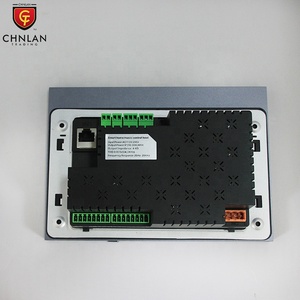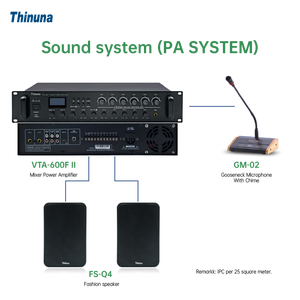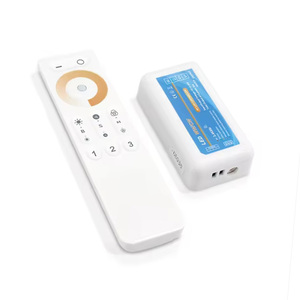(78240 products available)






































































































































































A zone controller, in simple terms, helps in controlling air conditioning in different areas of a building. The different types of zone controllers available in the market are as follows:
Single-zone controllers, as the name suggests, control a single zone. These are used in residential homes. It controls airflow and temperature for a single room, which means it's used in small spaces. It is also a more cost-effective solution for controlling a small space. It is easy to install and is a good choice for homeowners.
The two-zone controller is more advanced than the single-zone controller. It can control two separate zones or two rooms. It can be used in homes or small commercial buildings. It is a better solution when compared to a single-zone controller as it can control two zones, which means it can be used in a home where there is more than one room.
The three-zone controller is more advanced than the two-zone controller. It can control three separate zones or three rooms. This type of zone controller is good for homes with more than two rooms or a small office. It is more advanced than the two-zone controller as it can control three rooms.
The four-zone controller can control four rooms or four zones. It is a good choice for a larger home that has four separate rooms or a medium-sized office. It is a more advanced solution for a larger home, as it can control the temperature and airflow in four separate areas. This zone controller is a good choice for a home with more than three rooms, as it is more advanced than the three-zone controller and can control an additional room. It is easy to use and is a good choice for homeowners.
These controllers can control more than four zones. They are designed for larger commercial buildings or spaces. They offer more advanced control options. They allow for individual room or area temperature control. This means that people can control the temperature in their area. Some multi-zone controllers are also Wi-Fi-enabled, which means they can be controlled remotely.
Zone controllers have various features and functions that make them useful in hvac zoning systems. Below are some of them:
Zone controllers offer precise temperature control. They can measure room temperature and send the information to the HVAC system. The system then adjusts the temperature to the desired level in that room. The feature helps to save energy because it only heats or cools the room when needed.
Zone controllers support multi-zone control. That means they can control the temperature of different areas independently. Users can divide the heating and cooling system into zones. They can then control each area using a zone controller. Multi-zone control improves comfort because each room gets the right temperature. It also improves energy efficiency because the system only heats or cools the rooms that need it.
Some zone controllers are smart devices. They can connect to the internet through Wi-Fi. Users can then control the heating and cooling system remotely using a smartphone or tablet. Some smart controllers can learn user's habits and adjust the temperature automatically. They can also work with voice assistants. For example, a user can control the AC system using voice commands with Google Assistant or Amazon Alexa.
Zone controllers have dehumidification control. They can turn on the air conditioner to remove excess moisture in the air. The feature is useful in damp areas where high humidity can damage the building. Zone controllers also have sensors that detect the level of humidity in the air. They can then adjust the dehumidification process to maintain the desired humidity level.
Zone controllers give notifications when the filters need to be replaced. The filters remove dust and other particles from the air. They need to be cleaned or replaced regularly to ensure the HVAC system works efficiently. Some zone controllers have a filter timer that keeps track of filter usage. It will then alert the user when it is time to clean or replace the filter.
Zone controllers can be integrated with occupancy sensors. These sensors can detect when someone is in a room. The controller will then adjust the temperature to ensure the room is comfortable when it's occupied. It can also save energy by changing the temperature when the room is empty.
If a homeowner or business owner wants to have more control over the heating, ventilation, and air conditioning systems, they would want to purchase a zone controller. A zone controller is a control system for HVAC equipment that divides a building into different zones.
Here are some common usage scenarios for a zone controller:
When selecting zone controllers for heating and cooling systems, businesses should consider various factors to ensure they're getting the right products. Here are some of them:
When buying a zone controller, businesses should ensure that the models they choose are compatible with the existing HVAC system. They can check this by reviewing the specifications provided by the manufacturer. Also, they should check to see if the zone controller is compatible with various types of heating and cooling systems.
Zones controllers come in different designs and offer various features. Buyers should choose a model that will meet their needs. For example, if they want a zone controller with advanced features, they should go for a model that has the features. They should also check the durability and design of the zone controller before making any purchase.
The number of zones required for a particular HVAC system should be considered when choosing a zone controller. Some models can control more zones than others. Businesses should choose a model that is compatible with the number of zones they want to control.
Businesses should choose zone controllers from reputable manufacturers. They should read reviews and check the ratings of the different models to ensure they are getting a reliable product. Also, they should consider the warranty period as a zone controller that is backed by a long warranty period is likely to last for long.
Zone controllers require power to function. Businesses should choose a model that consumes less energy to save on power. Also, they should check if the model is compatible with the power capacity of the building.
Businesses should go for a model with a user-friendly interface. They should check the details of the user interface to see how easy it is to navigate the zone controller. Also, they should consider a model that supports multiple control options.
Q1: What is the difference between a thermostat and a zone controller?
A1: A thermostat controls the temperature of a single room, while a zone controller can manage the temperature of multiple rooms or zones. A zone controller can also control the dampers in the ductwork to direct airflow to different zones.
Q2: Can a zone controller be used with different types of heating and cooling systems?
A2: Yes, a zone controller is compatible with various HVAC systems, such as central air conditioning, heat pumps, and forced-air furnaces. However, it is essential to ensure compatibility and consult with HVAC professionals during installation.
Q3: How does a zone controller help save energy?
A3: A zone controller allows users to heat or cool only the areas that are being used. This prevents wasting energy on empty rooms. By optimizing temperature control for different areas, a zone controller can increase overall energy efficiency.
Q4: Is it possible to add more zones to an existing zone controller?
A4: Yes, additional zones can be added by installing more dampers in the ductwork and connecting them to the zone controller. However, this process should be done by a professional to ensure proper balancing and system performance.
Q5: How long does it take to install a zone controller?
A5: The installation time can vary depending on the complexity of the system and the number of zones. It can take a few hours to a full day. A professional should install a zone controller to ensure correct setup and integration with the existing HVAC system. The user should also set aside some time to learn how to use the new system efficiently.
For those considering a reliable option, the honeywell hz311 is a great choice for a single zone, while the hz322k honeywell can be utilized for more complex needs with hvac zone controller capabilities.